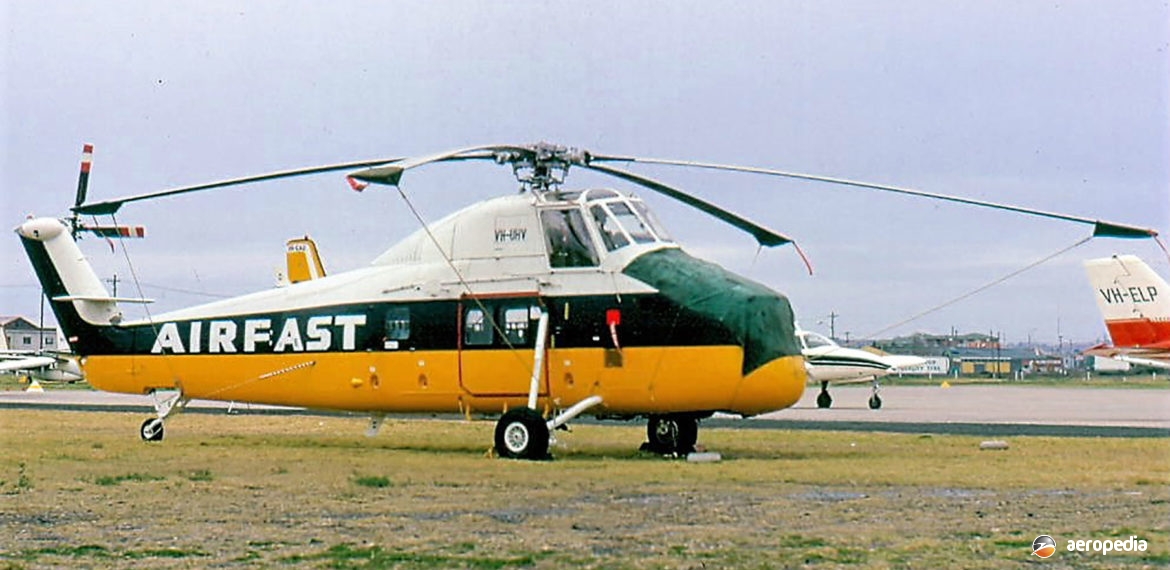Photograph:
Sikorsky S-58T VH-UHV (c/n 1128) at Mascot, NSW in August 1971 (David C Eyre)
Country of origin:
United States of America
Description:
General purpose utility helicopter
Power Plant:
(S-58T)
One 1,138 kw (1,525 shp) Pratt & Whitney Canada PT6T-3 coupled turboshaft
Specifications:
- (S-58T)
- Rotor diameter: 17.07 m (56 ft)
- Fuselage length: 14.4 m (47 ft 3 in)
- Max speed at sea level: 198 km/h (123 mph)
- Max cruising speed: 185 km/h (115 mph)
- Economical cruising speed: 148 km/h (92 mph)
- Hovering ceiling in ground effect: 1,490 m (4,900 ft)
- Hovering ceiling out of ground effect: 1,981 m (6,500 ft)
- Max range: 772 km (480 miles)
- Empty weight: 3,311 kg (7,300 lb)
- Loaded weight: 5,896 kg (13,000 lb)
History:
In April 1971 Sikorsky received approval from the US FAA to convert a number of S-58s to turbine power using the PT6T-3 Twin Pac in order to increase the power and load carrying capacity of the machine, and to meet heavy lift requirements of a number of operators. The first S-58T was flown on 19 August 1970, being an S-58 re-engined, and was powered by a 1,343 kw (1,800 shp) Pratt & Whitney PT6T-3 Twin Pac paired turboshaft. This was offered in kit form to operators of the type and a number were converted. Later Sikorsky offered the more powerful PT6T-6 Twin Pac which had a higher rating of 1,399 kw (1,875 shp) and with this unit the machine, known as the S-58T Mk II, was able to carry 16 passengers at speeds up to 26 km/h (16 mph) faster than the S-58C and had the additional safety margin of a second engine.
The Company subsequently produced almost 150 conversions or kits for local programs before selling the rights to this model to California Helicopters International in 1981. Twelve examples were supplied to the Royal Thai Air Force and these operated from Lop Buri. A further twelve were supplied to the Indonesian Air Force and these operated with Logistics Command. Others were supplied around the world, including two for VIP use in Argentina, three to Korea etc.
Another turboshaft conversion was that produced by Helitec Corp, which was also known as the S-58T. This involved the replacement of the Wright piston engine by a 626 kw (840 shp) AiResearch TSE331-3U-303 turboshaft de-rated to 485 kw (650 shp), this model having the exhaust outlet facing to the right side of the nose so as to offload the tail rotor.
A number of S-58Ts have operated in this region. In the early 1970s, following the oil crisis, the PENROD 74 oil drilling rig was towed to a point 161 km (100 miles) south of Invercargill in the Great Southern Basin, NZ and it remained in place until 1978. To service the rig a number of large helicopters with good load capability were operated, one of these being ZK-HIH (c/n 58-1663 – ex N82846, 81+01, WE+575, BuAer 150799) operated by Helicopters (NZ) Ltd of Nelson. In 1979 the Company won a contract to support a major Antarctic exploration program planned by West Germany and supplied two of its own Hughes 500Ds to work alongside a German registered S-58T (D-HBWR).
Others operated in this region have included SH-58E/Ts operated by Helicopter Utilities from Mascot, NSW. VH-UHV (c/n 1128 – ex N1165U) was registered in October 1971 but which was ditched 3 km (2 miles) west of Darwin on 25 March 1972; VH-UHW (c/n 1129 – ex N1165U) was registered in July 1971 and exported to Taiwan in June 1973, returning in January 1974 and being exported again to Indonesia in September 1974; and VH-UHX (c/n 1071 – ex Nr 62 French Army) was registered from July 1972 to March 1973 when it also was exported to operate in Indonesia.
Two examples were registered in New Guinea, being S-58D/Ts P2-PDX (c/n 58-787 – ex N64CH), which was exported to the United States in December 1976, becoming N64CH; and P2-PDY (c/n 58-1487 – ex N63CH, N49768, BuAer 149385) which was also exported to the United States in December 1976 as N63CH.

